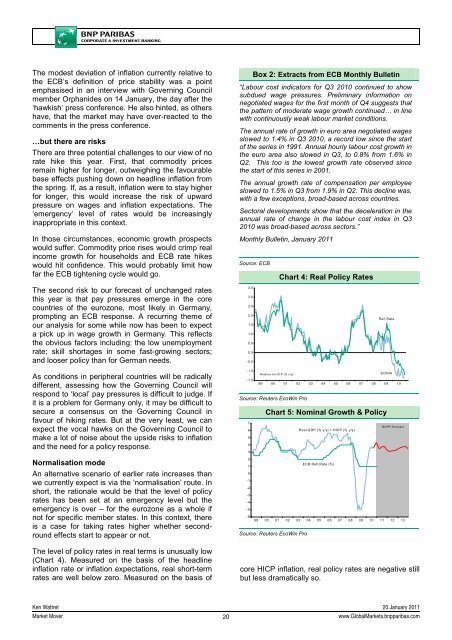Market Economics | Interest Rate Strategy - BNP PARIBAS ...
Market Economics | Interest Rate Strategy - BNP PARIBAS ...
Market Economics | Interest Rate Strategy - BNP PARIBAS ...
You also want an ePaper? Increase the reach of your titles
YUMPU automatically turns print PDFs into web optimized ePapers that Google loves.
The modest deviation of inflation currently relative to<br />
the ECB’s definition of price stability was a point<br />
emphasised in an interview with Governing Council<br />
member Orphanides on 14 January, the day after the<br />
‘hawkish’ press conference. He also hinted, as others<br />
have, that the market may have over-reacted to the<br />
comments in the press conference.<br />
…but there are risks<br />
There are three potential challenges to our view of no<br />
rate hike this year. First, that commodity prices<br />
remain higher for longer, outweighing the favourable<br />
base effects pushing down on headline inflation from<br />
the spring. If, as a result, inflation were to stay higher<br />
for longer, this would increase the risk of upward<br />
pressure on wages and inflation expectations. The<br />
‘emergency’ level of rates would be increasingly<br />
inappropriate in this context.<br />
In those circumstances, economic growth prospects<br />
would suffer. Commodity price rises would crimp real<br />
income growth for households and ECB rate hikes<br />
would hit confidence. This would probably limit how<br />
far the ECB tightening cycle would go.<br />
Box 2: Extracts from ECB Monthly Bulletin<br />
“Labour cost indicators for Q3 2010 continued to show<br />
subdued wage pressures. Preliminary information on<br />
negotiated wages for the first month of Q4 suggests that<br />
the pattern of moderate wage growth continued… in line<br />
with continuously weak labour market conditions.<br />
The annual rate of growth in euro area negotiated wages<br />
slowed to 1.4% in Q3 2010, a record low since the start<br />
of the series in 1991. Annual hourly labour cost growth in<br />
the euro area also slowed in Q3, to 0.8% from 1.6% in<br />
Q2. This too is the lowest growth rate observed since<br />
the start of this series in 2001.<br />
The annual growth rate of compensation per employee<br />
slowed to 1.5% in Q3 from 1.9% in Q2. This decline was,<br />
with a few exceptions, broad-based across countries.<br />
Sectoral developments show that the deceleration in the<br />
annual rate of change in the labour cost index in Q3<br />
2010 was broad-based across sectors.”<br />
Monthly Bulletin, January 2011<br />
Source: ECB<br />
Chart 4: Real Policy <strong>Rate</strong>s<br />
The second risk to our forecast of unchanged rates<br />
this year is that pay pressures emerge in the core<br />
countries of the eurozone, most likely in Germany,<br />
prompting an ECB response. A recurring theme of<br />
our analysis for some while now has been to expect<br />
a pick up in wage growth in Germany. This reflects<br />
the obvious factors including: the low unemployment<br />
rate; skill shortages in some fast-growing sectors;<br />
and looser policy than for German needs.<br />
3.5<br />
3.0<br />
2.5<br />
2.0<br />
1.5<br />
1.0<br />
0.5<br />
0.0<br />
-0.5<br />
Refi <strong>Rate</strong><br />
As conditions in peripheral countries will be radically<br />
different, assessing how the Governing Council will<br />
respond to ‘local’ pay pressures is difficult to judge. If<br />
it is a problem for Germany only, it may be difficult to<br />
secure a consensus on the Governing Council in<br />
favour of hiking rates. But at the very least, we can<br />
expect the vocal hawks on the Governing Council to<br />
make a lot of noise about the upside risks to inflation<br />
and the need for a policy response.<br />
Normalisation mode<br />
An alternative scenario of earlier rate increases than<br />
we currently expect is via the ‘normalisation’ route. In<br />
short, the rationale would be that the level of policy<br />
rates has been set at an emergency level but the<br />
emergency is over – for the eurozone as a whole if<br />
not for specific member states. In this context, there<br />
is a case for taking rates higher whether secondround<br />
effects start to appear or not.<br />
The level of policy rates in real terms is unusually low<br />
(Chart 4). Measured on the basis of the headline<br />
inflation rate or inflation expectations, real short-term<br />
rates are well below zero. Measured on the basis of<br />
-1.0<br />
-1.5<br />
Relative to HICP (% y/y)<br />
EONIA<br />
99 00 01 02 03 04 05 06 07 08 09 10<br />
Source: Reuters EcoWin Pro<br />
7<br />
6<br />
5<br />
4<br />
3<br />
2<br />
1<br />
0<br />
-1<br />
-2<br />
-3<br />
-4<br />
-5<br />
-6<br />
Chart 5: Nominal Growth & Policy<br />
99 00 01 02 03 04 05 06 07 08 09 10 11 12 13<br />
Source: Reuters EcoWin Pro<br />
Real GDP (% y/y) + HICP (% y/y)<br />
ECB Refi <strong>Rate</strong> (%)<br />
<strong>BNP</strong>P Forecast<br />
core HICP inflation, real policy rates are negative still<br />
but less dramatically so.<br />
Ken Wattret 20 January 2011<br />
<strong>Market</strong> Mover<br />
20<br />
www.Global<strong>Market</strong>s.bnpparibas.com

















